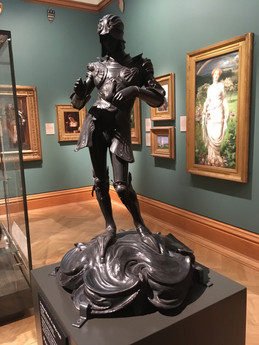The Ashmolean Museum - Enchanting Havens
- Lilium

- May 3, 2020
- 5 min read

The Ashmolean is the University of Oxford’s museum of art and archaeology, founded in 1683.
"The Ashmolean’s collections are extraordinarily diverse, representing most of the world’s great civilisations, with objects dating from 500,000 BC to the present day. Among many riches the museum holds the world’s greatest collection of Raphael drawings, the most important collection of Egyptian pre-Dynastic sculpture and ceramics outside Cairo, the only great Minoan collection in Britain, outstanding Anglo-Saxon treasures, and the foremost collection of modern Chinese painting in the Western world."

Elias Ashmole founded the Museum in 1683 as Britain's first public museum and gave it as a gift to the University becoming the world's first university museum.

"Because the knowledge of Nature is very necessary to human life and health."
- Elias Ashmole
The original Ashmolean collection was largely based on objects Ashmole had acquired from the gardeners, travellers and collectors John Tradescant the elder and younger.
I visited the Ashmolean for the first time at the beginning of a rather cold February accompanied by two companions who were equally starved for beauty as I was in the depths of such a dark winter. We stayed across the street at the Randolph Hotel so that we were able to simply walk across the road bang on opening time without needing to rush and giving us ample time for two breakfasts.
As soon as you walk into the Ashmolean, on the left of the door is a long corridor painted pale green with burgundy alcoves overflowing with Greek and Roman statues. Near the end of this corridor is someone who I was greatly looking forwards to seeing.
Antinous

Antinous, born 27 November, c. 111, was a Bithynian Greek youth and a favourite beloved of the Roman emperor Hadrian. Little is known of Antinous's life. He was probably introduced to Hadrian in 123, before being taken to Italy for a higher education. He had become the favourite of Hadrian by 128, when he was taken on a tour of the Empire as part of Hadrian's personal retinue. Antinous accompanied Hadrian during his attendance of the annual Eleusinian Mysteries in Athens, and was with him when he killed the Marousian lion in Libya. In October 130, as they were part of a flotilla going along the Nile, Antinous died amid mysterious circumstances.
Following his death, Hadrian deified Antinous and founded an organised cult devoted to his worship that spread throughout the Empire. Hadrian founded the city of Antinoöpolis close to Antinous's place of death, which became a cultic centre for the worship of Osiris-Antinous.
The worship of Antinous proved to be one of the most enduring and popular of cults of deified humans in the Roman empire, and events continued to be founded in his honor long after Hadrian's death.
Antinous became associated with homosexuality in Western culture, appearing in the work of Oscar Wilde and Fernando Pessoa. In February of 2019 the Ashmolean held an exhibition ANTINOUS: BOY MADE GOD which explored the spread of Antinous’ image and his empire-wide cult as a hero and god. Having visited the Antinous bust in Cambridge I made a beeline to the one held at the Ashmolean and it was equally beautiful.
"—A moment more, the trees had stooped to kiss
Pale Daphne just awakening from the swoon
Of tremulous laurels, lonely Salmacis
Had bared his barren beauty to the moon,
And through the vale with sad voluptuous smile Antinous had wandered,
the red lotus of the Nile.
"Down leaning from his black and clustering hair
To shade those slumberous eyelids — caverned bliss,"
The Burden of Itys - Oscar Wilde
The Pre-Raphaelites
I knew that waiting for me on the third floor, in room 66, were the Pre-Raphaelites, one of my favourite art movements but what I did not expect, was not only to see pieces by an artist from the New Sculpture movement, who's statues I greatly admired, but also pieces from someone who was much closer to home dominating the room.

On the centre wall of the gallery is a bookcase who's art, colours and design I recognised instantly, having seen it almost everyday for the first 16 years of my life. I have previously written about William Burgess and his designing of Castell Coch and Castell Caerdydd and it was a great and unexpected delight to discover one of his most beautiful pieces in Oxford.
"The Monumental Bookcase" or "Great Bookcase" was designed by William Burgess to hold his collections of books on art and architecture. It is 10 ft high and 5 ft wide, decorated by fourteen Pre-Raphaelite and Victorian artists, it has been described as "the most important example of Victorian painted furniture ever made." The paintings on the bookcase depict Pagan and Christian art depicted in "allegories of poetry, architectures, sculpture, painting and music."
In 1933, the bookcase was purchased for the Ashmolean by Kenneth Clark, Clark paying £50. After periods on display at the Victorian and Albert Museum and Knightshayes Court, the bookcase has now been returned to the Ashmolean. It is absolutely exquisite.
And stood in front of the bookcase was a piece made with yet more exquisite detail, and one I thought I may never have gotten to see. St George by Sir Alfred Gilbert.

In 1892, Sir Alfred Gilbert embarked in the most important of his Royal commissions – the Memorial to the Duke of Clarence, Prince Albert Victor, for St George’s Chapel, Windsor.
St George is a Bronze statue, standing at 18 inches high, and is an independent cast from the original model for the figure placed on the west end of the tomb of the Duke of Clarence in St. George's Chapel, Windsor.
Sir Alfred Gilbert and this particular statue was first introduced to me in the short film by John Betjeman "Passion for Churches".
"St. George might epitomise the moment in the history of English art when the last flowering of Pre-Raphaelitism merged with Art Nouveau, for although the subject might have been chosen by Wattsor Burne-Jones in the 1860s, this longlimbed youth's sinuous pose, the fanciful flutes and swirls of his costume, and above all his faintly effeminate air, place him firmly in the 1890s, close to Beardsley's drawings and Burne-Jones's late paintings."
- Richard Dormant, Gibson to Gilbert
The Still Life

On the second floor, past the music and the Baroque, is the Still Life gallery. And for a gardener like myself it was paradise. There isn't a square inch that isn't covered by rich paintings of overflowing urns and vases with magnificent blooms and bowls of fruit, the ripest peaches and grapes like glass, captured as though stuck in a dream of an eternal, luminous summers eve.
You could live with one of these paintings everyday for decades and always notice something new. Beverley Nichols describes such an experience in his book Merry Hall:
"The picture hangs over my desk as I write. It is a riot of a flower picture - one of the prettiest you ever saw, a riot of roses and peonies and irises and carnations and trailing vines, with bunches of grapes and curling leaves of kale with the dew still on them... a rich, glowing carnival of a flower piece....Well, one cold winter evening, before the war, I was standing by the fire, staring up at the picture, when for the hundredth time i noticed something new about it. There always was something new to be found, even if it was only a very tiny thing, such as a dewdrop on the petal of an iris or an ant crawling along the stem of a vine..."
Below is a link to an episode of the Open Arts Object where An Van Camp (Curator of Northern European Art) discusses Jan van Kessel, Decorative Still-Life Composition with a Porcelain Bowl, Fruit and Insects, 17th century, Ashmolean Museum, Oxford.
I have been to many museums across Britain but this one stands out as particularly enriching and I look forwards to spending many more hours there, gazing, as one in a trance, into the faces of Byzantine youths and dreaming of slipping into a still life painting to touch the dew from the petals.
Reading Recommendations & Content Considerations
Boy made god Folio Society Still Life
R.R.R Smith William Gaunt The National Gallery
























































































Comments